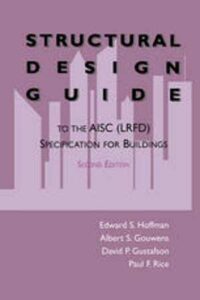نام کتاب: Structural Design Guide – To The Aisc (LRFD)
نویسنده: Edward S. Hoffman و Albert S. Gouwens و David P. Gustafson و Paul F. Rice
ویرایش: ۲
سال انتشار: ۱۹۹۶
کد ISBN کتاب: ۹۷۸۱۴۶۱۲۸۴۹۶۳, ۹۷۸۱۴۶۱۳۱۱۷۱۳
فرمت: PDF
تعداد صفحه: ۳۰۸
حجم کتاب: ۱۶ مگابایت
کیفیت کتاب: OCR
انتشارات: Springer Us
Description About Book Structural Design Guide – To The Aisc (LRFD) From Amazon
I I This book is intended to guide practicing structural engineers into more profitable routine designs with the AISC Load and Resistance Factor Design Specification (LRFD) for structural steel buildings. LRFD is a method of proportioning steel structures so that no applica ble limit state is exceeded when the structure is subjected to all appro priate factored load combinations. Strength limit states are related to safety, and concern maximum load carrying capacity, Serviceability limit states are related to performance under service load conditions such as deflections. The term “resistance” includes both strength states and serviceability limit states. LRFD is a new approach to the design of structural steel for buildings. It involves explicit consideration of limit states, multiple load factors and resistance factors, and implicit probabilistic determination of relia bility. The type of factoring used by LRFD differs from the allowable stress design of Chapters A through M of the 1989 Ninth ویرایشof the AISC Specifications for Allowable Stress Design, where only the resistance is divided by a factor of safety to obtain an allowable stress, and from the plastic design provisions of Chapter N, where the loads are multi plied by a common load factor of 1.7 for gravity loads and 1.3 for gravity loads acting with wind or seismic loads. LRFD offers the structural engineer greater flexibility, rationality, and economy than the previous 1989 Ninth ویرایشof the AISC Specifications for Allowable Stress Design.
درباره کتاب Structural Design Guide – To The Aisc (LRFD) ترجمه شده از گوگل
I I این کتاب به منظور راهنمایی مهندسین سازه ای در طرحهای معمول سودآورتر با مشخصات طراحی بار و مقاومت عامل AISC (LRFD) برای ساختمانهای فولادی سازه ای است. LRFD روشی برای تناسب سازه های فولادی است به طوری که وقتی سازه در معرض همه ترکیبات بار بارگذاری شده قرار گیرد ، از حالت حلی قابل اجرا فراتر نمی رود. حالتهای محدودیت قدرت مربوط به ایمنی است و مربوط به حداکثر ظرفیت حمل بار است ، حالتهای محدودیت قابلیت سرویس دهی به عملکرد تحت شرایط بار سرویس مانند انحرافات مربوط می شود. اصطلاح “مقاومت” شامل هر دو حالت قدرت و حالتهای محدودیت قابلیت استفاده می شود. LRFD یک رویکرد جدید در طراحی فولاد سازه ای برای ساختمان ها است. این شامل در نظر گرفتن صریح حالات محدود ، عوامل بار متعدد و عوامل مقاومت و تعیین احتمال احتمالی قابلیت اطمینان است. نوع فاکتورگیری که توسط LRFD استفاده می شود با طراحی تنش مجاز فصل های A تا M از چاپ نهم ۱۹۸۹ در مشخصات فنی AISC برای طراحی تنش مجاز متفاوت است ، که در آن تنها مقاومت به یک عامل ایمنی برای بدست آوردن تنش مجاز تقسیم می شود و از مقررات طراحی پلاستیک فصل N ، که در آن بارها با ضریب بار مشترک ۱٫۷ برای بارهای گرانشی و ۱٫۳ برای بارهای گرانشی که با باد یا بارهای لرزه ای عمل می کنند ، چند بار وارد می شوند. LRFD به مهندس سازه انعطاف پذیری ، عقلانیت و اقتصاد بیشتری نسبت به ویرایشنهم قبلی ۱۹۸۹ از مشخصات AISC برای طراحی تنش مجاز ، ارائه می دهد.
[box type=”info”]![]() جهت دسترسی به توضیحات این کتاب در Amazon اینجا کلیک کنید.
جهت دسترسی به توضیحات این کتاب در Amazon اینجا کلیک کنید.![]() در صورت خراب بودن لینک کتاب، در قسمت نظرات همین مطلب گزارش دهید.
در صورت خراب بودن لینک کتاب، در قسمت نظرات همین مطلب گزارش دهید.

